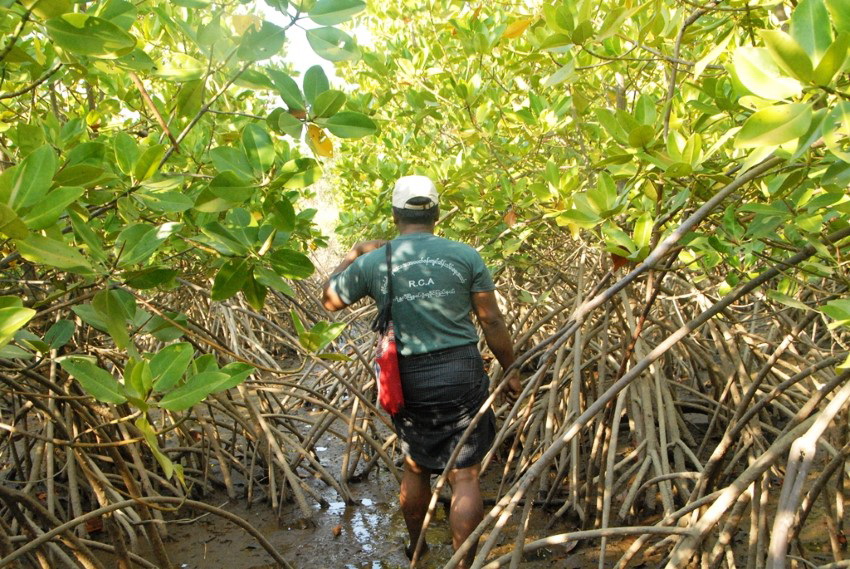KAN NGU VILLAGE, Arakan State — Until fairly recently, the residents of Kan Ngu, a coastal village in southern Arakan State, considered the mangroves in their area simply as another source of firewood and paid little attention to the shrinking forest.
“The locals did not carry out mangrove conservation in the past and cut it down without permission,” recalled Kyaw Win, a 62-year-old former fisherman and village leader.
But then, a few years ago, international aid groups begun to implement community projects that raised awareness of the mangroves’ important role in protecting the coastal environment and local attitudes quickly changed, he said.
“The locals now understand the impacts of mangrove deforestation and they no longer destroy the forest,” Kyaw Win said. “These mangrove forests are our benefactor, they are the habitat of fish, prawns and crabs. And we can earn money from catching these animals.” He added the he and other villagers had set up a local committee to conserve the mangrove ecosystem.
Mangroves are not only an important habitat, but also help protect the coastal environment against land erosion and floods caused by storms and occasional cyclones that lash the Arakan coast during rainy season.
The Kan Ngu Village committee is one of dozens that have been created in communities southern Arakan in recent years with the help of the Livelihoods and Food Security Trust Fund (LIFT). This poverty reduction donor fund supported by 12 governments launched the CLEARR project there in 2011 to help mangrove rehabilitation and provide agricultural and livelihood support.
Mangroves have been disappearing all along Burma’s coast, mostly due to human pressures, with an estimated loss of half of the 1.6 million acres of forest between 1980 and 2007, according to Maung Maung Kyi, a co-founder of the Rakhine Coastal Region Conservation Association.
The densely populated Irrawaddy Delta suffered the biggest losses and only fraction of the mangroves remains, but in southern Arakan conservation and reforestation efforts by local communities are starting to take root.
Maung Maung Kyi said the local committees helped restore some 12,000 acres of mangrove in Gwa Township, 30,000 acres in Thandwe Township and 65,000 acres in Taungup Township in recent years.
“Compared to other areas, mangrove forests in Rakhine remain strong. Some of the most diverse and rare species of mangrove forests in Southeast Asia are still found in Rakhine [Arakan],” he said.
Okkar, an officer at the Thandwe Township Forest Department, agreed that the tide could now be turning for mangrove ecosystems in southern Arakan State. “Mangrove reforestation has expanded thanks to the locals. It is a good trend,” he said.
In Kan Ngu, the Mangrove Conservation Group restored some 500 acres of forest. However, Kyaw Win and other local environmentalists said the mangroves continue to be threatened and warn that a lack of active government support is causing the community initiatives to lose steam.
Kyaw Win said the biggest threat to the mangroves comes from roving groups of migrating workers and loggers from Irrawaddy Division. These have been cutting down southern Rakhine’s mangroves since around 2009 to turn them into charcoal for sale in towns and cities.
“These commercial [charcoal] producers take out both small and big mangrove plants, and do illegal logging by motorboat,” he said. “They are still doing this business here as the authorities are turning a blind eye … We are angry about their actions as we have reforested these mangroves.”
Kyaw Win and another activist, Than Win from the Gwa Township Mangrove Conservation Committee, both recounted separate incidents in their villages during which residents apprehended loggers and handed them over to authorities, who then failed to act.
“We arrested the people who illegally cut the community mangroves last year and handed them over to the township forestry department and forest police. But they released them, as well as their tools, just after we left,” said Than Win.
Okkar, the Forest Department officer, claimed the authorities could take no legal action against the loggers as mangroves, including those being conserved by the communities, often lack official protected status.
“The authorities are preparing to turn these mangrove forests into protected areas as a measure to prevent deforestation,” he said, without offering details on how long it would take for the plans to be implemented.
Kyaw Win said villagers had contacted their state parliamentarians and appealed to Forest Department officials during public workshops, but there had been no reaction from authorities.
He said many locals had now “lost their enthusiasm” for protecting the mangroves because of a lack of government support, while villagers had increasingly come into conflict with the loggers, who continue to clear mangroves without government interference.
[related]
“The Forestry Department staff [approach] only fosters conflict between locals and loggers. We suggest that senior government officials end these practices,” Kyaw Win said.
Maung Maung Kyi, of the Rakhine Coastal Region Conservation Association, agreed more should be done from the government side to ensure better mangrove conservation. “The government needs to protect these forests from commercial activities and it should promote fuel substitution technologies” to replace charcoal making, he said.



